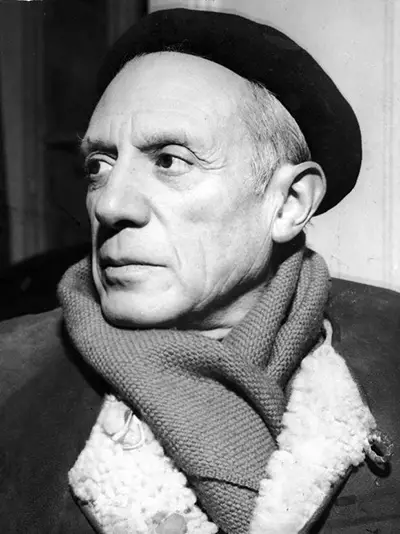Picasso's artwork throughout his lifetime covered a number of different art movements and categories, from classicism and cubism to the style of art which is the subject of this article; surrealism.
Surrealism is a cultural movement, which is not only confined to the world of art but also literature, music, theatre and philosophy.
The whole concept of surrealism, which came to prominence in the 1920s, is about chaos, an element of surprise and illogical depictions of reality.
Andre Breton's Surrealist manifesto of 1924, suggested that the cultural movement was an expression of 'psychic automatism' and 'the omnipotence of dream'.
This philosophical concept quickly disseminated to the world of art (as well as many other disciplines) and put into question the fundamentals of artistic creation.
With surrealism being principally concerned with a move away from reason and rationality, this paved the way for artists and art experts to question the notion that art is the sole product of an artist's creative imagination.
Picasso's Surrealism Period
Pablo Picasso's career is notorious for covering a wide range of artistic disciplines and so one cannot call him an absolute surrealist as such. There was however, particularly from the 1920s, evidence of surrealist influence in many of his works.
From around 1927, Picasso's work began to take the form of what could be deemed surrealist but there were signs of this influence in his previous works. Picasso drew from influences from the 'outside' and consciously nit picked specific elements of the discipline that, from his perspective, would improve his own artistic style.
In the mid-1930s, Picasso became increasingly associated with Surrealist thinkers, such as the surrealist poet, Paul Eluard. Indeed, it is clear that Picasso was influenced by the movement to some extent, as he even tried his hand at writing surrealist poetry himself and also took part in surrealist art exhibitions.
Evidence of Surrealism in Picasso's work
Evidence of the influence of surrealism in Picasso's work can be seen through his series of Bathers, constructed in 1927. These works depict images of the human body, in which some of the body parts have been altered and injected by stimulants that have caused abnormalities, that to society would be considered unattractive and perhaps grotesque.
This disregard for the conventional construction and visual proportion of the human body can be tied down to surrealist thought; a departure from rationality towards illogical and chaotic thought.
Surrealism is perhaps most apparent in Picasso's work, through his 1933 series of drawings, named 'An Anatomy'. These sketches depict images of little figures, which vaguely resemble that of the human form but are instead composed of non-organic components. These works, again show a disregard for the construction and proportion of the human form, giving human-like features to what are essentially machine-like elements.
Picasso's Guernica is a very famous work of art, which displays surrealist influence throughout. In 1937, Picasso composed an enormous-scale work, in order to demonstrate his anger against a war with Guernica; the mural sized piece was viewed by millions at the Paris World's Fair.
With its enormous size, much of Guernica's effect is through its scale; it immerses and engrosses all those who lay eyes on it and challenges the idea that war is heroic.
The image itself is very chaotic and death and destruction is rife. This chaotic nature has very obvious surrealist influence, as it is hard for the viewer to make sense of what is going on. As mentioned before, Picasso has a complete disregard for the proportion of the human form, as faces are distorted and abnormalities of the human features are evident throughout.
Surrealist techniques
In order to achieve a Surrealist piece of art, you need to encompass the philosophy behind the cultural movement, which is principally concerned with a departure from reason. For this reason, Surrealist techniques in art, or in any other discipline for that matter, put a real emphasis on the artist having free imagination and creative license, whilst avoiding conscious control.
Another aspect of surrealist techniques, is to draw inspiration from the unconscious mind, in the hope of achieving a free thinking but an illogical approach.
There are various influential surrealist artists who devised particular techniques to achieve this concept of random objects and images at the heart of surrealist thought. What's known as Frottage, is a surrealist technique, in which an image is created by placing a piece of paper over a rough surface and rubbing the paper with a pencil or crayon until it creates an impression of the surface underneath. See also Max Ernst.
Decalcomania is another surrealist technique, in which paint - usually from a large brush- is splashed on to a blank piece of paper and then covered and rubbed together with another, to create random patterns and combinations.
Automatic drawing is a further technique which encapsulates the surrealist idea of unpredictability, in which the artist should allow the line of the pen or whatever instrument they are using to take free roam and not have any conscious planning or structure.
Whilst Pablo Picasso was evidently inspired and influenced by the surrealist movement, his life's work took to several different artistic movements and he was not exclusive to one category.
From the 1930s onwards however, there was a clear surrealist approach to his works, with a complete disregard of the conventions and proportions of the human form. At the centre of surrealist art, some of which can be found in Picasso's works, was the concept of chaos and disorder; spontaneity and surprise.

